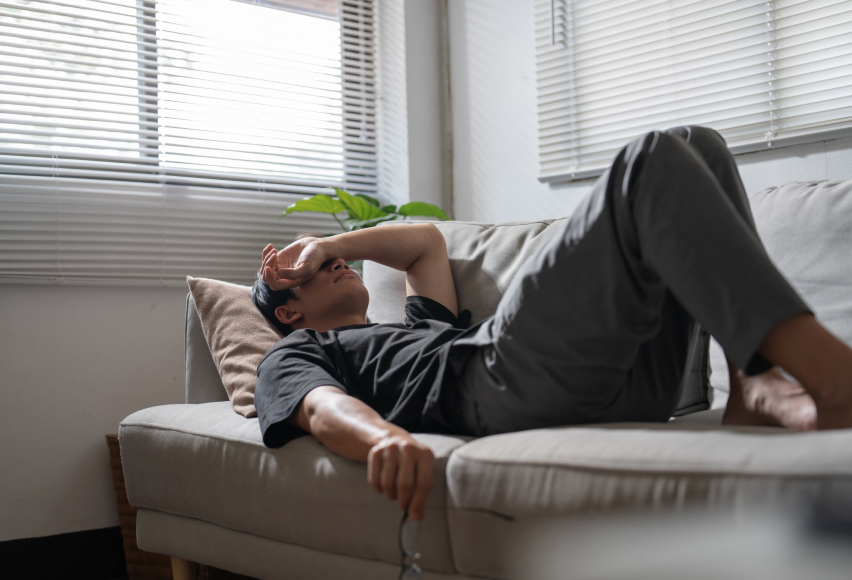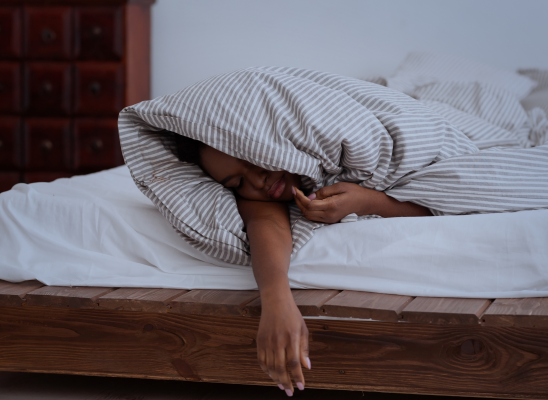
Online test
Find out the severity of your symptoms with this free online test
When your mind feels like it’s racing in circles, your chest tightens, and you just can’t stop worrying, it’s easy to wonder: Is this just anxiety, or is something else going on—like OCD?
It’s a fair question. From the outside (and sometimes even from the inside), anxiety and obsessive-compulsive disorder can look a lot alike. Both can flood your brain with fear, make it hard to focus, and leave you feeling emotionally drained.
But here’s the thing—they’re not the same. They share some common ground, but they work in different ways. Getting clear on what you’re dealing with can make a big difference when it comes to treatment and support.
So, What Exactly Is Anxiety?
At its core, anxiety is something we all experience. It’s part of the brain’s alarm system—meant to keep us alert and safe. For example, if you’re crossing the street and suddenly see a car coming fast, that jolt of panic you feel? That’s anxiety doing its job.
But sometimes, anxiety shows up when it’s not really needed. And instead of fading once the “threat” passes, it sticks around and starts interfering with everyday life. That’s when it can turn into an anxiety disorder.
There are several different types—like generalized anxiety disorder (GAD), panic disorder, phobias, and social anxiety. What they all have in common are things like non stop worrying, physical tension, racing thoughts, and a tendency to avoid the stuff that feels scary or overwhelming (American Psychiatric Association, 2013).
Let’s say there’s a high school student named Jenna. She has a class presentation coming up, and the nerves hit hard. She can’t stop imagining what might go wrong—what if she forgets what to say? What if people laugh? She feels nauseous, considers faking sick, and even thinks about dropping the class. For someone with GAD, this kind of worry doesn’t just come and go—it latches on and spreads to other areas of life, too.
Then, What Is OCD?
OCD—short for obsessive-compulsive disorder—is its own category. It’s a condition made up of two main parts:
- Obsessions are unwanted thoughts, images, or urges that pop into your head and cause anxiety or distress.
- Compulsions are the things you feel you have to do (either outwardly or mentally) to feel better or stop something bad from happening.
For example, take Luis. He keeps thinking, “What if I left the stove on and the house burns down?” He’s checked it already—multiple times—but the thought keeps coming back. So he checks again. And again. That brief relief doesn’t last, though, and soon he’s back in front of the stove. That’s the OCD cycle at work (Abramowitz, McKay, & Storch, 2018).
Where Anxiety and OCD Overlap
It’s no surprise that these two get mixed up. In fact, before 2013, OCD was officially considered an anxiety disorder. Even though it has its own diagnosis now, anxiety still plays a central role in OCD (APA, 2013).
Here are a few ways they’re similar:
- Both come with emotional discomfort. Whether it’s anxiety or OCD, you’re probably feeling a lot of fear, dread, or unease.
- They both involve “what if” thinking. An anxious mind might say, “What if I mess this up?” while OCD might whisper, “What if I accidentally harmed someone and didn’t realize it?”
- Avoidance is common. Someone with anxiety might avoid public speaking. Someone with OCD might avoid public bathrooms or shaking hands because of contamination fears.
- They drain your mental energy. You can get stuck replaying scenarios, seeking reassurance, or trying to get rid of the discomfort.
Because of all this overlap, it’s not always easy to tell them apart—especially when someone has both.
Where the Two Split
Despite their similarities, there are a couple of clear ways anxiety and OCD differ.
The Compulsion Piece
The most obvious difference? Compulsions.
In general anxiety, you might avoid things or seek reassurance—but you’re probably not doing detailed, repetitive rituals. With OCD, the compulsions are more intense and feel like must-do actions, even when you know they don’t really make sense (Storch et al., 2015).
Let’s break that down:
- Anxiety: “I’m worried about catching a cold.” You read about symptoms or text a friend for comfort.
- OCD: “I touched a doorknob and now I might give my family a deadly illness.” You wash your hands in a specific way five times until it feels exactly right.
Compulsions aren’t just habits—they feel urgent, and skipping them can cause a huge spike in distress.
The Nature of the Thoughts
Anxious thoughts usually revolve around real-life concerns. You might worry about money, health, or relationships. The thoughts can be exaggerated, but they’re grounded in reality.
OCD thoughts, on the other hand, are often intrusive and disturbing. They might seem random or go against your values completely. Some people worry they’re secretly dangerous or bad because of a thought they had. These are called ego-dystonic thoughts—they feel wrong or foreign to the person having them (Salkovskis, Wahl, & Witzig, 2019).
The Anxiety Inside OCD
Here’s the twist: OCD is driven by anxiety. That intense discomfort is exactly why compulsions happen. They’re meant to relieve the fear.
Let’s go back to Luis and the stove. His thought—“What if I left it on?”—spikes his anxiety. Checking the stove gives him temporary relief. But soon, the doubt creeps back in, and he checks again. Every time he checks, it reinforces the idea that the thought was worth worrying about. That’s the trap. It’s a cycle that keeps feeding itself.
Even though someone with OCD often knows the thought is irrational, that knowing doesn’t stop the anxiety. Logic takes a back seat when the fear feels real.
Can Someone Have Both Anxiety and OCD?
Yes! Most people with OCD also deal with other mental health conditions. In fact, about 9 out of 10 people with OCD have at least one more disorder. The most common ones include anxiety, mood disorders, impulse-control disorders, and substance use disorders. Research shows that OCD usually appears after anxiety disorders (about 8 out of 10 cases) (Stein et al. 2019).
That’s part of what makes diagnosis tricky. You might be dealing with general anxiety, social anxiety, panic attacks—and OCD, all at once. But understanding how they interact is a big step toward finding the right tools to manage them.
Is It Anxiety or OCD? Some Signs to Look For
Here are a few clues that what you’re dealing with might lean more toward OCD:
- You get stuck on certain thoughts that feel intrusive, uncomfortable, or “off.”
- You feel the need to do specific actions—whether outward (like washing) or mental (like counting or reviewing things).
- You know the behavior doesn’t make total sense, but it feels impossible to skip.
- You crave certainty in a way that feels all-consuming.
The thoughts or behaviors take up a lot of your day and interfere with school, work, or relationships.
If any of that resonates, it might be worth talking to a therapist—especially someone trained to spot OCD.
Getting the Right Help
When it comes to anxiety, CBT (cognitive behavioral therapy) is a go-to treatment. It focuses on challenging negative thought patterns, building confidence, and learning how to manage the unknown. Medications like SSRIs can also help balance brain chemistry and reduce symptoms.
OCD requires a more specific approach: Exposure and Response Prevention (ERP). This form of therapy helps people face the thoughts that scare them without doing the usual compulsions. Over time, the brain learns to stop seeing those thoughts as dangerous.
For example, someone with Contamination OCD might touch something “dirty” and resist the urge to wash. At first, their anxiety skyrockets—but as they sit with it, the feeling fades. That’s the power of ERP (Krebs & Heyman, 2015).
You're Not Broken—You're Just Human
Whether you’re struggling with anxiety, OCD, or both, it doesn’t mean there’s something “wrong” with you. These conditions are incredibly common—and treatable. The key is recognizing when they’re starting to take over and knowing that support is out there.
If you’re not sure which one you’re dealing with, or if you just know something feels off, you don’t have to figure it out alone. A trained mental health professional can help you sort through it and come up with a plan that fits you.
And if you’re looking for care from experts who truly understand OCD, head over to StopOCD.com. You’ll find resources, treatment options, and compassionate professionals ready to help you move forward.
References
- Abramowitz, J. S., McKay, D., & Storch, E. A. (2018). The Wiley Handbook of Obsessive Compulsive Disorders. Wiley-Blackwell.
- American Psychiatric Association. (2013). Diagnostic and statistical manual of mental disorders (5th ed.).
- Krebs, G., & Heyman, I. (2015). Obsessive-compulsive disorder in children and adolescents. BMJ, 350, h2106.https://pubmed.ncbi.nlm.nih.gov/25398447/
- Stein, D. J., Costa, D. L. C., Lochner, C., Miguel, E. C., Reddy, Y. C. J., Shavitt, R. G., van den Heuvel, O. A., Simpson, H. B., Fernandez de la Cruz, L., Phillips, M. L., Fontenelle, L. F., Zohar, J., & Fineberg, N. A. (2019). Obsessive–compulsive disorder. Nature Reviews Disease Primers, 5(1), 52. https://www.ncbi.nlm.nih.gov/pmc/articles/PMC7370844/
- Pallanti, S., Grassi, G., Cantisani, A., Sarrecchia, E., & Pellegrini, M. (2011). Obsessive–Compulsive Disorder Comorbidity: Clinical Assessment and Therapeutic Implications. Frontiers in Psychiatry, 2, 17262. https://doi.org/10.3389/fpsyt.2011.00070
Online test
Find out the severity of your symptoms with this free online test
Start your journey with StopOCD
Take control of your life and find freedom from OCD through professional therapy and evidence-based cognitive behavioral techniques.
Start Now



